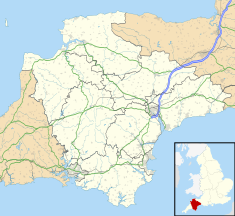Okehampton Town Hall
| Okehampton Town Hall | |
|---|---|
 Okehampton Town Hall | |
| Location | Fore Street, Okehampton |
| Coordinates | 50°44′21″N 4°00′12″W / 50.7391°N 4.0033°W |
| Built | 1685 |
| Architectural style(s) | Neoclassical style |
Listed Building – Grade II* | |
| Official name | Town Hall, Fore Street |
| Designated | 5 February 1952 |
| Reference no. | 1105855 |
Okehampton Town Hall is a municipal building in Fore Street, Okehampton, Devon, England. The town hall, which is the meeting place of Okehampton Town Council, is a Grade II* listed building.[1]
History[edit]
The first municipal building in the town was a medieval guildhall in Middle Row which itself was located in the centre of Fore Street. By the early 19th century Middle Row was in a dilapidated state and, in 1800, legislation was enacted giving authority to the borough council to demolish the whole street.[2][3]
The current building was commissioned by John Northmore, an attorney to the Court of King's Bench.[4] It was designed in the neoclassical style, built in ashlar granite and was completed in 1685.[1] The design involved a symmetrical main frontage with five bays facing onto Fore Street; the central bay featured a doorway flanked by pilasters supporting a canted bay window with an ogee-shaped roof on the first floor; there was a sash window with a cornice supported by consoles on the second floor. The outer bays were fenestrated with sash windows on all three floors. At roof level, there was a modillioned cornice which was broken to create an open pediment above the central bay.[1] Internally, the principal room was a large wooden panelled reception room on the ground floor.[1]
The building was acquired by the local member of parliament, John Luxmoore, in 1740.[1] It then passed down the Luxmoore family until it was acquired by the borough council for use as a town hall in 1821.[5] A carving of the borough coat of arms, finished in gold and silver leaf, was installed in the open pediment.[6] Okehampton had a very small electorate and two dominant patrons, who in the 18th century were Thomas Pitt and the Duke of Bedford, which meant it was recognised by the UK Parliament as a rotten borough.[7] Its right to elect members of parliament was removed by the Reform Act 1832[8] and its borough council, which continued to meet in the town hall, was reformed under the Municipal Corporations Act 1883.[9][10]
A classroom for teaching science and technology was established in the town hall in 1893.[11] The town hall continued to serve as the headquarters of the borough council for much of the 20th century,[12] but ceased to be the local seat of government when the enlarged West Devon District Council was formed at Tavistock in 1974.[13] It instead became the meeting place of Okehampton Town Council.[14]
Works of art in the town hall include three paintings by Richard Caton Woodville Jr. depicting Saladin's cavalry charging the Crusaders,[15] Napoleon and his marshals watching a battle[16] and a 19th-century cavalry charge.[17] There is also a portrait of an old man by Gaspar de Crayer entitled Memento mori,[18] a painting by John Frederick Herring Sr. depicting a farmyard[19] and a still life painting by Cornelis de Heem.[20]
See also[edit]
References[edit]
- ^ a b c d e Historic England. "Town Hall, Fore Street (1105855)". National Heritage List for England. Retrieved 29 December 2021.
- ^ Young, Edward H. (1930). Okehampton. Devonshire Association for the Advancement of Science, Literature and Art. p. 76.
- ^ Journals of the House of Commons. Vol. 55. UK Parliament. 1799. p. 218.
- ^ "Northmore, Thomas (c.1643-1713), of St. Thomas Nigh, Exeter, Devon and the Inner Temple". History of Parliament. Retrieved 29 December 2021.
- ^ "Okehampton Town Hall". Heritage Gateway. Retrieved 29 December 2021.
- ^ "Okehampton Town Hall". Studio OK. Retrieved 29 December 2021.
- ^ "The Constituencies". History of Parliament. Retrieved 29 December 2021.
- ^ "The History of Politics: The Rotten Boroughs of England". Julia Herdman Books. 21 April 2017. Retrieved 21 October 2019.
- ^ Municipal Corporations Act 1883 (46 & 46 Vict. Ch. 18) (PDF). 1883. Retrieved 21 December 2021.
- ^ "Okehampton MB". Vision of Britain. Retrieved 29 December 2021.
- ^ "Okehampton". Kelly's Directory of Devon. 1902. Retrieved 29 December 2021.
- ^ "No. 45930". The London Gazette. 16 March 1973. p. 3540.
- ^ Local Government Act 1972. 1972 c.70. The Stationery Office Ltd. 1997. ISBN 0-10-547072-4.
- ^ "Welcome". Okehampton Town Council. Retrieved 29 December 2021.
- ^ Woodville, Richard Caton. "Saladin's Cavalry Charging the Crusaders". Art UK. Retrieved 29 December 2021.
- ^ Woodville, Richard Caton. "Napoleon and His Marshals Watching a Battle". Art UK. Retrieved 29 December 2021.
- ^ Woodville, Richard Caton. "A Cavalry Charge". Art UK. Retrieved 29 December 2021.
- ^ de Crayer, Gaspar. "Memento mori". Art UK. Retrieved 29 December 2021.
- ^ Herring, John Frederick. "Farmyard". Art UK. Retrieved 29 December 2021.
- ^ de Heem, Cornelis. "Still Life with Grapes, Peaches and a Bohemian Glass Goblet". Art UK. Retrieved 29 December 2021.

